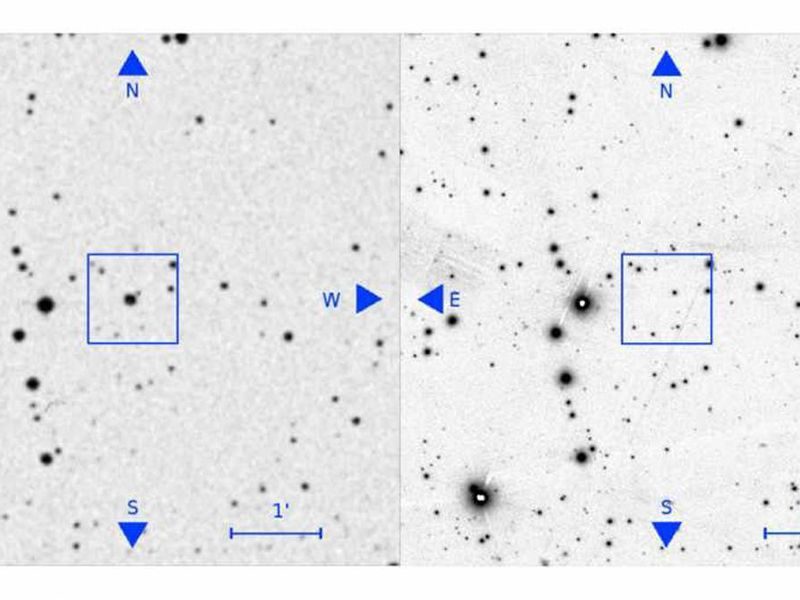
The group's project, called Vanishing and Appearing Sources during a Century of Observations (VASCO) has been comparing mapped stars listed in the U.S. Naval Observatory Catalogue (USNO) B 1.0, dating from the 1950s, with those in another, more recent sky catalog, the Pan-STARRS Data Release (DR1). A total of 150,000 objects were found in the older catalogue (which lists 600 million stars) that did not have a readily identifiable counterpart in the new star survey, even though the Pan-STARRS Data Release includes stars that are five times less bright than the faintest light sources included in USNO. Of these 150,000 anomalies, the authors visually inspected 24,000 candidates and discovered that 100 of these point sources of light appear only in the older star survey. And since then, apparently, they've vanished.
Certainly, the most parsimonious explanation for the missing stars is that they are natural phenomena such as extremely flaring dwarf planets, failed supernova, or stars that might directly collapse into a black hole. But there seem to me too many anomalies to explain all the vanished stars as known natural phenomena. In their current paper, the authors themselves discuss the possibility that they're seeing unknown phenomena, or that the vanished "stars" could be relics of technologically advanced civilizations, particularly the theoretical mega-engineering projects known as Dyson spheres.
Perhaps the missing objects are signs of an advanced civilization. But they're probably not Dyson spheres. First, it would be hard to explain why and how such a giant construction project, completely shading out the light of the host star, could be done within the short period of less than a century. But more importantly, Brooks Harrop and I showed nearly 10 years ago that "traditional" Dyson spheres are not gravitationally stable. Even if one could be built near a star like our Sun, it would require more total mass than is available in all our Solar System's planets, moons, and asteroids.
So what are the missing stars? A few might be explained as flaring stars whose brightness dropped below the detection limit, or stars that collapsed directly into a black hole. A large portion, however, might represent new stages in the life cycle of certain stars or new stellar phenomena that have not yet been seen. That by itself would be an exciting topic to investigate.
Another intriguing question: Where are the missing stars? Are they at the same location, just not emitting light anymore? Or perhaps they've moved to some other location. If the latter, could some of these represent huge starships, the size of moons or planets, that moved outside the field of view? This, of course, is a highly speculative suggestion. But it would address the hotly discussed Fermi Paradox, and would, in principle, be testable. If these "missing" light sources represent giant starships, some should appear in new star surveys in some other part of the sky. In an ideal case, we might even be able to track their trajectories through time. It would be challenging, no doubt, to pick out such motions against other background movements in space, like those of stars spinning around the center of their galaxy. Nevertheless, my suggestion to the authors is to focus their future work on light sources that suddenly appear in new star surveys, and see whether they can be correlated to the stars that vanished.
In her paper, Villarroel suggests another very promising direction for future research — to search for clusters of missing stars, which, if they exist, could be related to new natural phenomena in a particular region of space, or perhaps to activities of an extraterrestrial civilization. Either way, the authors have turned up something that may become very important for both astrophysical and SETI investigations.



Reader Comments
Merry Christmas and Love to all✌👋👋
There is new ways to look into space now ,not just visible light .
new recuring novas are being cataloged all the time
stars are the twinkling faerie lights of the cosmic current
Ben Davidson the suspiciousObserver explains it really well[Link]
Those Stars obviously have better things to do than be catalogued by some locust "civilization"...
Whatever.
R.C.
R.C.
Being facetious.
RC
The Phoenix appears every 500 years .... ? If the phenomenon is a Solar nova then various sources abouut disasters on the planet may establish that.
The Solar Grand Minimum periods suggest a border before a large solar event, which recurs before every nova?
Remember this?
[Link]
[Link]
L, R.C.
If all stars are in motion relative to each other - expanding or otherwise, then we should see at least incremental changes of position - NOT just in terms of Earth's orbit, axial tilt and spin. But has anyone ever heard of such an observation?
Space dust - plasma or whatever - is capable of intervening between us and stars and blocking the view.
It seems that 'bad astronomy' or any other shills for the PTB would post an immediate reply, with proof, to that question, but like you, I remain unaware of same.
(As we know, they'd just claim that such is due to the 'astronomical' (pun intended) distances involved vs. the sensitivity of our instruments. But if they're that bad, how can they likewise claim to see stuff so many BILLION light years away?)
Anyone who replies: please address your analysis to binra's question, not mine, which would be far easier to 'shuck and dive' away from.
R.C.
[Link] - Dark matter may have punched a hole in the Milky Way
The research, led by Ana Bonaca of the Harvard-Smithsonian Center for Astrophysics, reveals a curious abnormality in an otherwise uniform stream of stars orbiting in the Milky Way’s outer halo. Specifically, the researchers found an odd kink within the stream that they think was caused by a “close encounter with a massive and dense perturber,” according to the presentation’s abstract.
But Im certainly no astronomer.